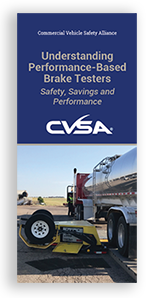A performance-based brake tester (PBBT) is a machine that assesses the braking performance of a vehicle. This is done through direct measurements of the brake forces at each wheel end, axle or for the entire vehicle. PBBT devices include roller dynamometers (roller-dyno) and flat plate brake testers. Each device can determine brake forces without restriction to the brake type (disc vs. drum) or energy supply (air, hydraulic or electric). In addition, PBBTs based on mechanical or electronic decelerometers can assess the overall vehicle braking capability through a stopping performance test in which deceleration and/or stopping distance is obtained, also independent of brake type or application method.
The PBBT measures the slow speed brake force and weight at each wheel, adds up the total vehicle brake force, and divides it by the total vehicle weight to determine overall vehicle braking efficiency. U.S. federal regulations and the North American Standard Out-of-Service Criteria require a minimum braking efficiency of 43.5 percent. If your vehicle’s braking efficiency is below 43.5 percent, they are not providing the minimum stopping power required and are in need of service.
View an example of what an inspection report will show if you are tested on a PBBT. If any wheel end is showing braking efficiency below 43.5 percent, there’s likely something wrong with that brake, even if no violation is found.
PBBTs have been used worldwide for decades for both safety inspections and as part of regular preventative maintenance work. In the United States, as of Feb. 5, 2003, PBBTs that meet the Federal Motor Carrier Safety Administration’s functional specifications can be used for enforcement of minimum braking performance requirements on commercial motor vehicles. Additionally, as of April 1, 2008, CVSA approved PBBT-based out-of-service authority for roadside enforcement officials throughout North America.
PBBT Inspection Results
The results of a PBBT test are generally consistent with a visual inspection of a brake system; however, although a visual inspection can indicate a potential problem with a brake component, the actual brake performance cannot be determined by visual inspection. In general, the PBBT method is more objective and usually in favor of the vehicle during a roadside inspection as well as in a maintenance facility.
If a vehicle “fails” a PBBT test, there are a limited number of reasons the brake forces may be low when compared with the vehicle weight. The first check should be whether the vehicle or axle is overloaded. If so, reducing the weight will increase the brake force-to-weight ratio. After this, obvious mechanical problems such as pushrod travel, broken or missing components, air system problems or degraded/inadequate lining should be checked.
Repairs and/or adjustments should be made, after which a re-test on the PBBT can be used to ensure that the poorly performing brake(s) have been brought up to adequate standards. If a problem with the linings (i.e. glazed, low friction value, etc.) is the cause, in most cases something more than a simple adjustment will be required to bring the vehicle to a safe operating condition.
Download a brochure about PBBTs. (Español) (Français)
PBBT Electric Trailer Brake Data Collection
CVSA’s PBBT Users Forum seeks to gather information about inspecting combinations with electric-braked trailers. The purpose is to improve awareness and maintenance by electric brake users and to refine our procedures for inspecting these combinations. We request that any time you inspect an electric-trailer-equipped combination, please complete and submit our online form.
Go to the PBBT electric trailer brake data collection online form.
Period of data collection: June 1-July 31, 2022


